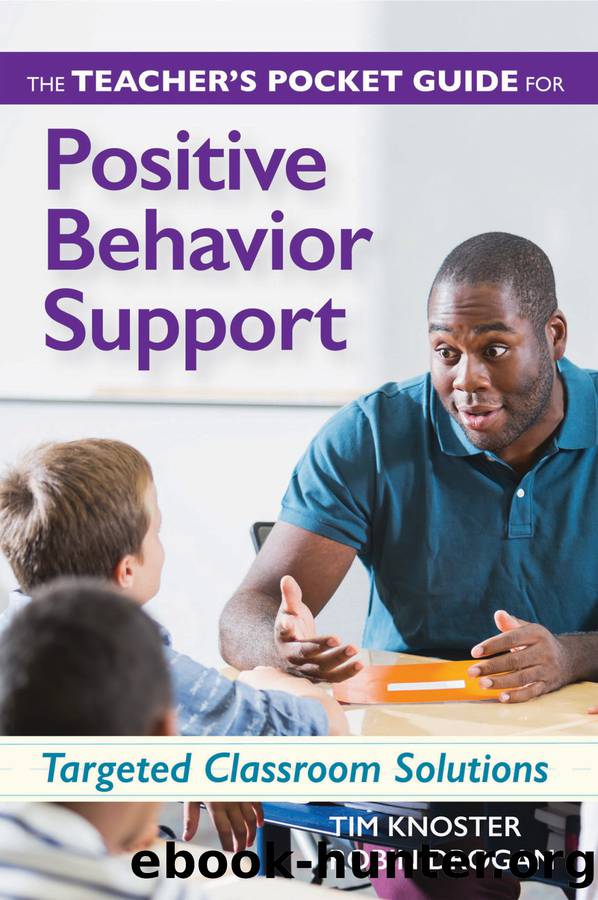The Teacher's Pocket Guide for Positive Behavior Support: Targeted Classroom Solutions by Knoster Timothy;Drogan Robin; & Robin Drogan Ph.D

Author:Knoster, Timothy;Drogan, Robin; & Robin Drogan, Ph.D. [Knoster, Tim & Drogan, Robin]
Language: eng
Format: epub
Tags: EDUCATION / Behavioral Management, EDUCATION / Classroom Management, EDUCATION / Inclusive Education
Publisher: Brookes Publishing
Published: 2016-05-07T00:00:00+00:00
Mentoring: How It Worked for Julie
Julie is a high-achieving tenth-grade student involved in a number of school activities. She has a history of success both in the classroom and socially with her classmates, and she is very popular with both staff and many students at her high school. Given this profile, at least on the surface, it appeared that there should be no concerns with Julie. However, she was increasingly feeling out of control, and her sleep patterns were becoming erratic. Julie reported this was in part due to overloading herself with so many things to do, as well as difficulties in managing the internal stress associated with her own expectations to excel in everything that she took on. She shared her feelings with one of her close friends, who in turn encouraged her to talk with a teacher. Julieâs friend was persistent to the point that Julie did, in fact, talk with Mrs. Aurand, who was Julieâs class advisor and her instructor in an advanced placement psychology course. Mrs. Aurand then consulted the guidance counselor and Tier 2 team.
Julieâs high school had been implementing PBIS for the past few years and was in the process of trying to further refine its implementation to better integrate timely access to school- and community-based mental health services to students in need. The guidance counselor, Mrs. Aurand, Julie, and her parents sat down to talk through the concerns and to explore possible targeted supports for Julie. A number of targeted approaches were identified, with some starting immediately and others to be staggered in as soon as possible. The guidance counselor began to meet with Julie on a regular basis and, whenever Julie felt the need, was on call for her at school. Meetings were kept brief to avoid adding too much to Julieâs schedule. Based on consensus of all involved, scheduled meetings occurred daily for a little more than a week while additional targeted supports were being organized.
The high school had been operating the Big Brothers Big Sisters Program as a part of providing additional targeted supports to students with particular profiles. Julieâs profile did not appear to align with the design of that particular mentoring program; however, when talking with the guidance counselor, Julie had expressed interest in connecting with someone a little bit older than her who had previously had some similar experiences, preferably a young female professional or perhaps a college student. The Tier 2 team decided to establish an additional type of mentoring approach based on the current circumstances with Julie.
After considering a variety of options, the Tier 2 team reached out to a local university to recruit a small pool of high-achieving female students who might potentially become a mentor for Julie. Following the acquisition of required clearances and permission forms for all involved, the guidance counselor provided some initial training in mentoring to three potential mentors. Julie was provided opportunities to interact with all three students, and she felt particularly comfortable with one sophomore engineering major who herself had worked through some similar experiences in high school.
Download
This site does not store any files on its server. We only index and link to content provided by other sites. Please contact the content providers to delete copyright contents if any and email us, we'll remove relevant links or contents immediately.
| Behavioral Disorders | Communicative Disorders |
| Gifted Students | Inclusive Education |
| Learning Disabled | Mentally Disabled |
| Physically Disabled |
The Art of Coaching Workbook by Elena Aguilar(50126)
Trainspotting by Irvine Welsh(21042)
Twilight of the Idols With the Antichrist and Ecce Homo by Friedrich Nietzsche(18307)
Fangirl by Rainbow Rowell(8803)
Periodization Training for Sports by Tudor Bompa(7929)
Change Your Questions, Change Your Life by Marilee Adams(7385)
This Is How You Lose Her by Junot Diaz(6457)
Asking the Right Questions: A Guide to Critical Thinking by M. Neil Browne & Stuart M. Keeley(5361)
Grit by Angela Duckworth(5303)
Red Sparrow by Jason Matthews(5202)
Paper Towns by Green John(4807)
Room 212 by Kate Stewart(4742)
Ken Follett - World without end by Ken Follett(4449)
The Sports Rules Book by Human Kinetics(4081)
Housekeeping by Marilynne Robinson(4070)
Double Down (Diary of a Wimpy Kid Book 11) by Jeff Kinney(3935)
Papillon (English) by Henri Charrière(3918)
The Motorcycle Diaries by Ernesto Che Guevara(3790)
Exercise Technique Manual for Resistance Training by National Strength & Conditioning Association(3790)
